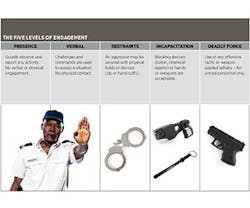A security guard confronts a trespasser. When the officer’s verbal commands are ignored, he or she chooses to physically restrain and pin the individual to the ground. The situation has been resolved, but did the guard make the right decision?
The answer to the question lies in your use of force policy. It is one of the most critical documents you need to have if you use a security force on your property.
“The policy outlines the appropriate amount of force required in the management of a incident by first responders,” explains Sean Ahrens, global practice leader for security consulting and design services at Aon Risk Solutions.
If you don’t have a use of force policy or assume your security provider is responsible for its creation, you are exposing your company and its security force to unnecessary risk.
“From a legal standpoint, you’ve left yourself in a precarious situation,” cautions Jesse Stanley, a security consultant for Strongside Principles and a member of ASIS. “What you end up with is informal, institutional knowledge that doesn’t carry well in a court system.”
“Security is a non-delegable legal duty, even if you hire someone else to cover your security needs,” adds John Elliott Leighton, a civil trial lawyer and manager partner of Leighton Law, which specializes in personal injury.
Don’t leave room for any doubt – learn how to sit down with your security team and iron out the details of your policy. PageBreak
What is Use of Force?
A use of force policy details the different engagement options available to first responders and specifies which actions are appropriate for certain situations. Its purpose is to minimize security threats and diffuse high-intensity emotions.
For example, anger can escalate, but it’s hard to maintain extreme levels for long periods of time, explains Ahrens. An officer can take advantage of fluctuations in a person’s emotional state by intervening before the potential aggressor reaches their boiling point.
“The force continuum is designed to break the modality of anger,” Ahrens says. “Use of force options are available so a guard can intercede into a person’s anger and circumvent the process of someone continuing to act out.”
Taking a page from law enforcement, a full use of force policy includes five levels of engagement:
- Presence: guards serve as visual deterrents and observe and report any activity.
- Verbal: vocals are used to challenge and command individuals of interest.
- Restraints: officers may use physical holds or devices to secure an aggressor. This is the first level where hands-on contact is approved for defensive use.
- Incapacitation: first responders may use hands-as-weapons or blocking devices (baton, Taser) on soft tissue to resolve a situation. This may include chemical agents.
- Deadly force: generally reserved for armed security, but also includes the use of any offensive tactic or weapon applied in a lethal manner.
“Remember that the use of force is predicated on the location, tools, and resources available to incident responders, and the situation itself,” Ahrens stresses. These levels aren’t hard and fast rules, but the policy is a frame of reference that security can automatically recall during an exchange.
Due to liability concerns, most building owners will depend on the first two levels, with special provisions built in for extreme scenarios.
“The most common is a ‘no use of force’ or a ‘hands off’ policy,” notes Stanley. “Others will outline a ‘minimal’ or ‘reasonable’ use of force policy.” PageBreak
What Should the Policy Include?
Creating a use of force policy should be a formalized process – you shouldn’t create a document on your own and start training people, cautions Ahrens.
You need to reach out to your legal and HR departments to confirm the policy is in line with corporate objectives. You also need to ensure that your policy abides by state and municipal restrictions.
“Start with what the laws are in your jurisdiction,” Leighton recommends. “Look at when the police are permitted to use force and work backwards from there.”
As you develop the policy, it’s important to discuss hypothetical scenarios when use of force could be warranted. If there’s a domestic assault situation, for example, what are the pros and cons of restraining the assailant?
“During these conversations, you’ll find you have a bunch of dilemmas and imperfect answers,” Stanley says. “But discussing how the use of force could play out in different situations will help you shape and clarify the policy.”
How Do I Enforce the Policy?
Security need to be trained on your policy. Otherwise, they could mistakenly skip necessary steps, jump to a tactic that’s more aggressive than warranted, or use an approach that’s not approved.
Policies should be written in accessible language for easy comprehensibility. “You need a well-written policy that is simple, effective, and straight-to-the-point,” Stanley recommends. “Will your security team understand and remember it?”
Also make sure your policy isn’t ironclad to the point that it doesn’t account for catch-22s, notes Ahrens.
It’s too easy to find videos online showing guards passively watching someone get assaulted because they were instructed to only observe and report. Had they been given permission to engage in life-threatening situations only, many companies could avoid a potential PR nightmare.
“It’s worthwhile for your leadership to identify what’s important to the company culture and have that reflected in all of your policies,” stresses Stanley, “especially in one as sensitive, volatile, and legally vulnerable as use of force.”
Jennie Morton [email protected] is associate editor of BUILDINGS.
About the Author
Jennie Morton
A former BUILDINGS editor, Jennie Morton is a freelance writer specializing in commercial architecture, IoT and proptech.
